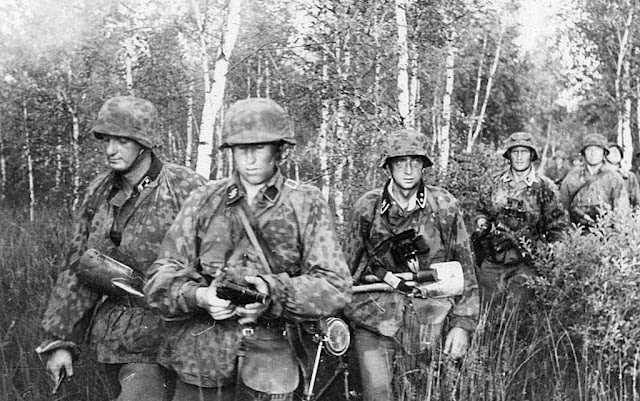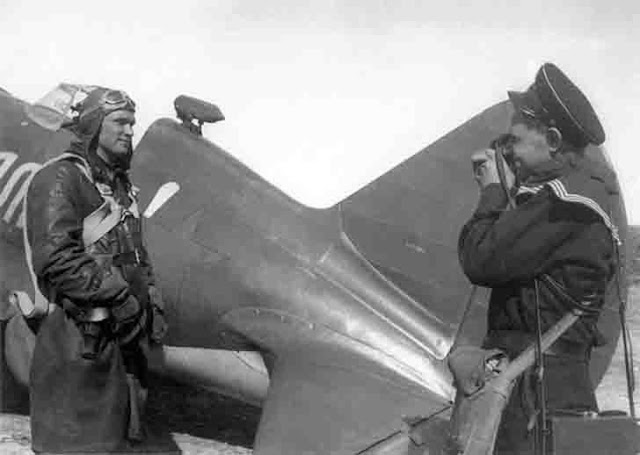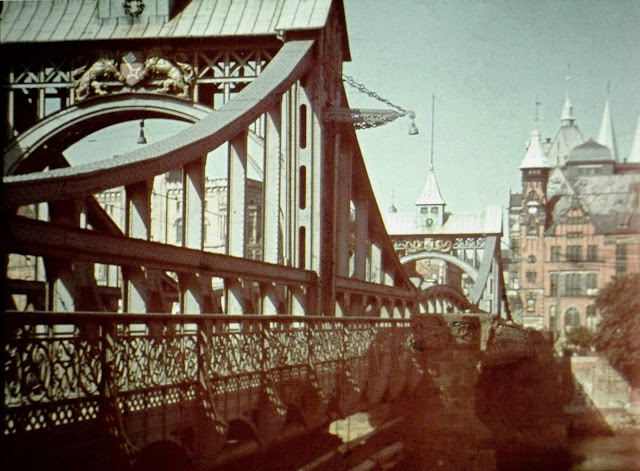Monday 17 November 1941
 |
| Troops in winter camouflage on the march in Russia, 17 November 1941 (Vorphal, Federal Archive Picture 146-2005-0078A). |
Eastern Front: Marshal Mannerheim and General Hjalmar Siilasvuo of the Finnish high command on 17 November 1941 directs its forces to cease active offensive operations and dig in for the winter where they stood. This includes forces pursuing Operation Silver Fox, the advance toward the Murmansk Railway at Loukhi, and Operation Arctic Fox, the offensive in the far north toward Murmansk. Since operations out of Finland have been led by Finnish forces and the performance of German units has been decidedly mediocre, this independent decision must be accepted by the Germans as a fait accompli. The German leaders are not happy about this decision and continually attempt to reverse it, with only occasional and minimal success. Thus, in the largest sense, 17 November 1941 marks the end of Finnish attempts to advance into the Soviet Union during World War II.
The Finns have several different reasons for halting operations. They have been receiving intense diplomatic pressure from the United States and Great Britain to stop advancing, using the argument that further advances would imperil Lend-Lease supplies to the Soviet Union. The Wehrmacht troops in Finland have performed poorly, being unused to the forests and marshes that characterize the front, and have no prospects for being reinforced. This has put the main military burden on the Finns, who have been fighting hard and losing dozens of men every day and sometimes many more.
Having the most effective troops under their control has given the Finns leverage to make whatever decisions they want without regard to German desires. In addition, and perhaps most importantly, Mannerheim always has taken the position that he never wants to create the impression that Finland is a threat to the Soviet Union. Mannerheim knows that his country could never survive such a relationship in the long run. Recovering lost territory is one thing, but attempting to conquer all of Russia is completely out of the question. Thus, ending operations makes more sense than aggravating further Finland's already tense relations with the USSR, Great Britain, and the United States.
The halt in activities leaves the Finnish front on the outskirts of Leningrad, on the Svir River, and running up parallel to the Murmansk Railway all the way to Petsamo. In the Arctic Fox area, Siilasvuo has waited until the Finnish 3rd Division west of Loukhi has killed 3,000 Soviet soldiers and captures 2,600, leaving them with a secure front and no Soviet remnants in the rear. The Murmansk Railway remains about 30 km (19 miles) to the east. Further north, in the Silver Fox sector, the front already has been stable for about two months, and the Finnish decision merely codifies the actual state of operations. Here, the German Mountain Corps Norway at least has occupied the Petsamo area and its extremely valuable nickel mines. However, the true prize, the port of Murmansk, remains far over the horizon. Supply difficulties all but rule out any resumption of the offensive in either sector without full Finnish cooperation which is not forthcoming.
German Military: World War I flying ace Generalluftzeugmeister Generaloberst Ernst Udet, German Director General of Air Armament, commits suicide in Berlin. He shoots himself in the head while on the telephone with his girlfriend after expressing deep unhappiness with the actions of Reichsmarschall Hermann Goering, yelling as his final words, "Man of iron (Goering's nickname), why have you abandoned me!" (some sources claim he wrote this on the headboard of his bed in red). Udet has been in lingering disfavor with both Hitler and Goering due to the failures of the Luftwaffe during the Battle of Britain. Blaming Udet is unfair, as he never intruded on strategy, but the alternative is to blame Goering himself for the failure (and where the true blame does lie) and that is not acceptable. The fault did lie somewhat in aircraft procurement, as the Luftwaffe's medium bombers were inadequate to the strategic bombing tasks asked of them, but Goering had the final say in those decisions during the 1930s. Udet's death is an ill omen for the future course of the war, and the events surrounding the Udet funeral set in motion changes that will drastically affect the Luftwaffe's future.
 |
| "A torpedo being secured to a Fairey Swordfish for a practice flight." This is for a practice flight from Royal Naval Air Station Crail, Scotland on 17 November 1941. © IWM (A 6277). |
 |
| "A Wren parachute packer carefully arranging the parachute for packing." Royal Naval Air Station Crail, Scotland, 17 November 1941. © IWM (A 6286). |
 |
| Gerhard Pleiß (20 April 1915 – 17 November 1941). An ordinary soldier, Pleiß stood on a mine and lost both his legs, and died on the way to the hospital. An officer in the Leibstandart SS Adolf Hitler, 1st Company, Pleiß compiled a photo album that chronicles the early actions of his unit. KIA 17 November 1941. |
 |
| Ernst Udet. Despite his unassuming looks, he was an outstanding stunt pilot. |
Future History: Tove Træsnæs is born in Oslo, Norway. At the age of 8, she emigrates with her mother to the United States. During the 1960s, she becomes very interested in makeup and opens her own makeup center. At some point, she anglicizes her name to Tova. On February 24, 1973, Tove marries motion picture and television star Ernest Borgnine. In the mid-1970s, Tova expands her business by buying the rights to a cactus-based face cream made from a formula by a Mexican family. Tova pioneers the sale of fragrances and cremes on the QVC network, which buys her out in 2002. Her fragrance, Tova Signature, ultimately becomes QVC's top-selling perfume. As of 2021, Tova Borgnine, now widowed, remains active in the marketing field.
November 1941
November 1, 1941: Finns Attack Toward Murmansk Railway
November 2, 1941: Manstein Isolates Sevastopol
November 3, 1941: Japan Prepares to Attack
November 4, 1941: German Advances in the South
November 5, 1941: Last Peace Effort By Japan
November 6, 1941: Stalin Casts Blame in an Unexpected Direction
November 7, 1941: Stalin's Big Parade
November 8, 1941: Germans Take Tikhvin
November 9, 1941: Duisburg Convoy Destruction
November 10, 1941: Manstein Attacks Sevastopol
November 11, 1941: Finland's Double Game Erupts
November 12, 1941: T-34 Tanks Take Charge
November 13, 1941: German Orsha Conference
November 14, 1941: German Supply Network Breaking Down
November 15, 1941: Operation Typhoon Resumes
November 16, 1941: Manstein Captures Kerch
November 17, 1941: Finland Halts Operations
November 18, 1941: British Operation Crusader
November 19, 1941: Sydney vs. Kormoran Duel
November 20, 1941: The US Rejects Final Japanese Demand
November 21, 1941: Germans Take Rostov
November 22, 1941: Kleist in Trouble at Rostov
November 23, 1941: Germans Take Klin, Huge Battle in North Africa
November 24, 1941: Rommel Counterattacks
November 25, 1941: HMS Barham Sunk
November 26, 1941: Japanese Fleet Sails
November 27, 1941: British Relieve Tobruk
November 28, 1941: Rostov Evacuated, German Closest Approach to Moscow
November 29, 1941: Hitler Furious About Retreat
November 30, 1941: Japan Sets the Date for its Attack
2020
November 1941
November 1, 1941: Finns Attack Toward Murmansk Railway
November 2, 1941: Manstein Isolates Sevastopol
November 3, 1941: Japan Prepares to Attack
November 4, 1941: German Advances in the South
November 5, 1941: Last Peace Effort By Japan
November 6, 1941: Stalin Casts Blame in an Unexpected Direction
November 7, 1941: Stalin's Big Parade
November 8, 1941: Germans Take Tikhvin
November 9, 1941: Duisburg Convoy Destruction
November 10, 1941: Manstein Attacks Sevastopol
November 11, 1941: Finland's Double Game Erupts
November 12, 1941: T-34 Tanks Take Charge
November 13, 1941: German Orsha Conference
November 14, 1941: German Supply Network Breaking Down
November 15, 1941: Operation Typhoon Resumes
November 16, 1941: Manstein Captures Kerch
November 17, 1941: Finland Halts Operations
November 18, 1941: British Operation Crusader
November 19, 1941: Sydney vs. Kormoran Duel
November 20, 1941: The US Rejects Final Japanese Demand
November 21, 1941: Germans Take Rostov
November 22, 1941: Kleist in Trouble at Rostov
November 23, 1941: Germans Take Klin, Huge Battle in North Africa
November 24, 1941: Rommel Counterattacks
November 25, 1941: HMS Barham Sunk
November 26, 1941: Japanese Fleet Sails
November 27, 1941: British Relieve Tobruk
November 28, 1941: Rostov Evacuated, German Closest Approach to Moscow
November 29, 1941: Hitler Furious About Retreat
November 30, 1941: Japan Sets the Date for its Attack
2020





























